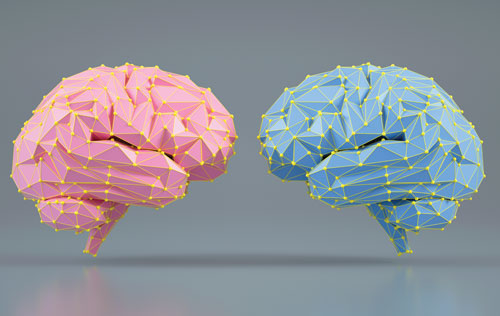A new study of children may ultimately help guide neuroscientists and clinicians to a better understanding of how both biological sex and the sociocultural concept of gender are variably reflected in functional brain networks, with potential implications for diagnosis and treatment of psychiatric disorders.
The study, published in Science Advances, employed a sample of nearly 5,000 children ages 9 to 10 years old from the Adolescent Brain Cognitive Development study, which was established to follow young participants as they grow into young adults.
Using neuroimaging and a suite of computational tools, the authors found that functional connectivity within brain networks varied based on both sex and gender. Although they found some overlap in the brain networks affected, the functional representation of gender was quite different from that of biological sex.
Correlates of biological sex were preferentially associated with somatoform, visual, control, and limbic networks, while correlates of gender were widely distributed throughout the brain. The results suggest that these variable associations may be behind sex and gender differences seen in psychiatric disorders, the authors said.
First of a Series of Studies
The study authors defined the term “sex” to “indicate features of an individual’s physical anatomy, physiology, genetics, and/or hormones at birth,” while “gender” was used to “indicate features of an individual’s attitude, feelings, and behaviors.” Gender was assessed with both parental and child questionnaires that asked about sex-typed play behaviors, feelings of gender contentedness, and observations of gender dysphoria.
The researchers also built computer models that tried to identify a child’s sex or gender based on functional connectivity patterns. The models were able to reliably identify individuals’ assigned sex or parent-reported gender, but were less predictive about self-reported gender scores in either sex—suggesting self-gender identify is a complex phenomenon.
Lead author Elvisha Dhamala, Ph.D., of the Institute of Behavioral Science at the Feinstein Institutes for Medical Research in Manhasset, New York, told Psychiatric News that the goal is for this to be the first of a series of studies looking at sex and gender over the human lifespan. She cautioned against “any causal interpretations” of the findings, given that the research evaluated only cross-sectional correlations.
This study is “an initial effort to understand these relationships, and a lot more work is required,” Dhamala said. “Subsequent studies examining longitudinal trajectories of these relationships in specific contexts and populations will be able to capture more nuanced details about these relationships that our current study could not.”
Dhamala and colleagues noted that the relationships between biological and social factors are “intertwined and reciprocal.” Thus, a given individual’s experiences are shaped by their biological sex, their conception of gender, and the sociocultural milieu in which they exist. These relationships are complex and converge in ways that impact brain organization and function.
Discussions of sex and gender have been a source of political controversy, but the focus of this study was to deepen understanding of how the variable expression of sex and gender in the brain may eventually be reflected in better approaches to the diagnosis, prognosis, and care of psychiatric disorders, many of which have sex-based difference in risk and presentation. While the results are not conclusive, they “suggest that sex and gender are irreducible to one another not only in society but also in biology,” the authors wrote.
Individual and Interactive Effects
Sheila Shanmugen, M.D., Ph.D., an assistant professor of psychiatry at the University of Pennsylvania’s Perelman School of Medicine, said the research by Dhamala and colleagues is a significant initial step in the exploration of a neglected area of study. “Sex and gender differences in brain networks have historically been understudied, and the terms used to describe each are often conflated,” Shanmugen said.
“We therefore do not have a great understanding of the individual and interactive effects of sex and gender on the brain and how these effects relate to sex and gender differences in the presentation, prevalence, and manifestation of psychiatric disorders.”
The study’s finding that sex and gender “have common and dissociable impacts on brain functional networks in children ages 9 to 10 years old” has potentially significant implications, Shanmugen said. “These effects were seen in networks that underlie diverse aspects of cognition and behavior, and as such, studying the effects of sex and gender on normative brain development may help us better understand risk and resilience to psychiatric disorders such as depression and ADHD.”
Given that this is one of the first studies comparing effects of sex versus gender on brain networks, there remains much research to be done, Shanmugen said. “Next steps likely include determining the individual and interactive effects of sex and gender on additional aspects of brain-network structure and function, how these effects evolve during adolescence and adulthood, and how these effects relate to sex and gender differences in psychiatric symptoms,” she said.
The ultimate goal, however, “would be that this type of information may help us better understand risk versus resilience to psychiatric disorders that show sex- and/or gender-based differences in prevalence or presentation,” Shanmugen said, “or this information may help inform treatments that may be optimized by functional brain mapping—for example, transcranial magnetic brain stimulation.”
The study was supported by Northwell Health Advancing Women in Science and Medicine Career Development Award; Feinstein Institutes for Medical Research Emerging Scientist Award; National Institute of Mental Health; National University of Singapore Yong Loo Lin School of Medicine; Singapore’s National Medical Research Council Center; and Temasek Foundation and Center for Curiosity. ■

